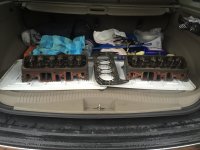Hi…having had a few beers during a lovely first sail of the season today…I’m finding myself wondering around these new Mercury outboard running temperatures. Having had this Merc 115 CT 2.1l engine for a few years now…the first thing I noticed and continued to wonder around, is how cool it runs. It runs around 52 degrees C. About 125 Fahrenheit I think. Seems very cold running to me. But is exactly around what the manual says it should be.
Having been used to either old school outboards or GM inboards all my days…the latter of which, I also own…runs at 150-160 Fahrenheit…the outboard is significantly cooler running.
The thought around this came to mind more prominently again this week when I changed the oil on her. I’ve changed the oil on this many times now and even a couple of times a season too. Each time, there is a slight whiff of fuel in e oil. Nothing serious…but enough to make me wonder around the engine low running temps, perhaps having an effect on such a thing.
Anyone any similar thoughts ?
Having been used to either old school outboards or GM inboards all my days…the latter of which, I also own…runs at 150-160 Fahrenheit…the outboard is significantly cooler running.
The thought around this came to mind more prominently again this week when I changed the oil on her. I’ve changed the oil on this many times now and even a couple of times a season too. Each time, there is a slight whiff of fuel in e oil. Nothing serious…but enough to make me wonder around the engine low running temps, perhaps having an effect on such a thing.
Anyone any similar thoughts ?






















